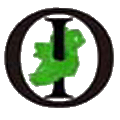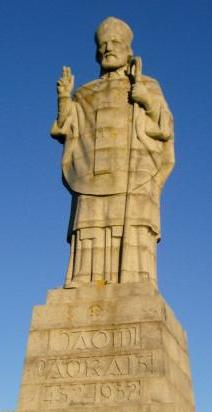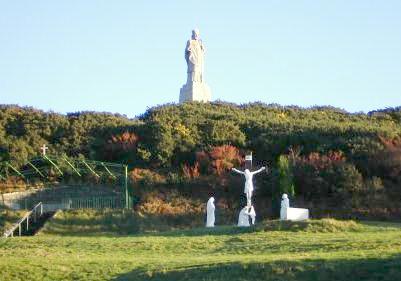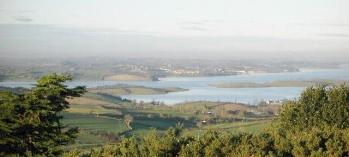 |
| |
Patron
Saint of Ireland |
||
| Saint
Patrick (about 389-461) is the patron saint of Ireland Patrick was born in Wales during the period of the Roman occupation. His father was a wealthy nobleman and a Christian. When Patrick was 16 years old, he was captured by raiders probably acting under the orders of the Irish king Niall Noigiallach ('Niall of the Nine Hostages'). they sold him as a slave in Ireland to a chieftain named Miliuc. He served as a shepherd for him on Slemmish mountain in Ulster. After six years it is said he stowed away on a ship loaded with Irish Wolfhounds and managed to escape to Britain. During his period of slavery Patrick formulated the idea of converting the Irish to Christianity. After his escape to prepare himself for that task, he studied in the monastery of Lerins, on an island off the southeast coast of France. Patrick also went to Auxerre, France, and studied religion under Saint Germanus, a French bishop. Partly because Patrick's earlier education was inadequate, his religious superiors were reluctant to let him return to Ireland as a missionary. Ireland already had a missionary Palladius, the first Irish missionary bishop, when he died in 431. Pope Celestine I then sent Patrick to Ireland. Patrick is reputed to have landed in Ireland at
the mouth of the Slaney river which flows into Early Christian missionaries seem to have employed the tactic of incorporating pagan rituals along with the Christian, a policy which ultimately brought the Irish church into conflict with Rome. It is contended by some that this led, in the fullness of time to the Anglo Norman invasion of Ireland in the twelfth century. Patrick brought clergymen from England and France for his new churches. He succeeded in his mission in Ireland, even though many British clergymen opposed him and the way he organized his churches, the dating of Easter being a particularly contentious issue, this opposition was ongoing for about three hundred years only being resolved in 702. Patrick preached in Ireland for the rest of his life, he was buried with great ceremony at Downpatrick County Down. His writings serve Many stories about Patrick are based only on legend. One of the best-known tales tells how he charmed the snakes of Ireland into the sea so they were drowned, although in all probability the snake never reached Ireland, the land bridge being flooded by the rising sea level before they reached there. Ireland is said to have only about two thirds of the species of flora and fauna that inhabit England. Many scholars contend that the snakes were metaphorical, referring to the the Druids who had played a significant role in directing Irish society for millennia. According to another legend, Patrick used a three leaf shamrock to illustrate the idea of the Trinity. Many people believe the shamrock came to be the traditional symbol of Ireland as a result of this legend. Today, Irish Catholics throughout the world celebrate Saint Patrick's Day on his feast day, March 17 The celebrations held in New York are on a particularly grand scale. It is said that the first St Patrick's day parade in New York was organized by the British army, in an effort to entice Irishmen to join their ranks. Around Ireland there are many monuments and shrines to St Patrick one in Co Down was built in 1932 to celebrate 1500th anniversary of Patrick's landing. A granite statue was carved from stone quarried at Ballymagreshan north of Castlewellan and erected on a small mountain east of Downpatrick formerly known as Slieve William it was renamed Slieve Patrick. An interesting story was related to us recently by a nephew of one of the stonemasons involved in erecting the statue, apparently before setting the head section in place each of the masons set a coin in the mortar for good luck. As part of the millennium celebrations in 2000 a grotto was built. Each year on 17th March (St Patrick's day.) Pilgrims walk from Downpatrick to the shrine. On a clear day can be seen the Mourne mountains
to the west, the Sperrin's to the north west cave hill to the north east,
the Cumbrian mountains and the Isle of Mann I recently came across this page on an excellent site by Pat Flannery, the site has many authorative articles on Ireland. Today 2nd January 2008 I spent most of the afternoon watching Pat's videos on You Tube which is what led me to his site, this link should take you to his video on The Great O'Neill (Hugh O'Neill Earl of Tyrone), if you are interested in Irish history, please visit the link you will find that Pat is a man who has the ability and courage to expose the truth by cutting through the propaganda of Irish history, written by the the victors both eclectic and military. See also Saint Patrick in Irish
history. |
||
|
|


 Strangford Lough near
Strangford Lough near as the most
important sources of information about Patrick's life and work. He wrote
Confession, an account of his spiritual development, to justify his mission
to Ireland and to express his humility and thankfulness that God called
him to serve the Irish. Patrick also wrote Letter to Coroticus. In this
letter, he criticized a raid on Ireland conducted by Coroticus, a British
chieftain. Several of Patrick's converts were killed during the raid.
The letter also shows Patrick's resentment of the scornful attitude of
British clergymen and nobility toward the Irish.
as the most
important sources of information about Patrick's life and work. He wrote
Confession, an account of his spiritual development, to justify his mission
to Ireland and to express his humility and thankfulness that God called
him to serve the Irish. Patrick also wrote Letter to Coroticus. In this
letter, he criticized a raid on Ireland conducted by Coroticus, a British
chieftain. Several of Patrick's converts were killed during the raid.
The letter also shows Patrick's resentment of the scornful attitude of
British clergymen and nobility toward the Irish.
